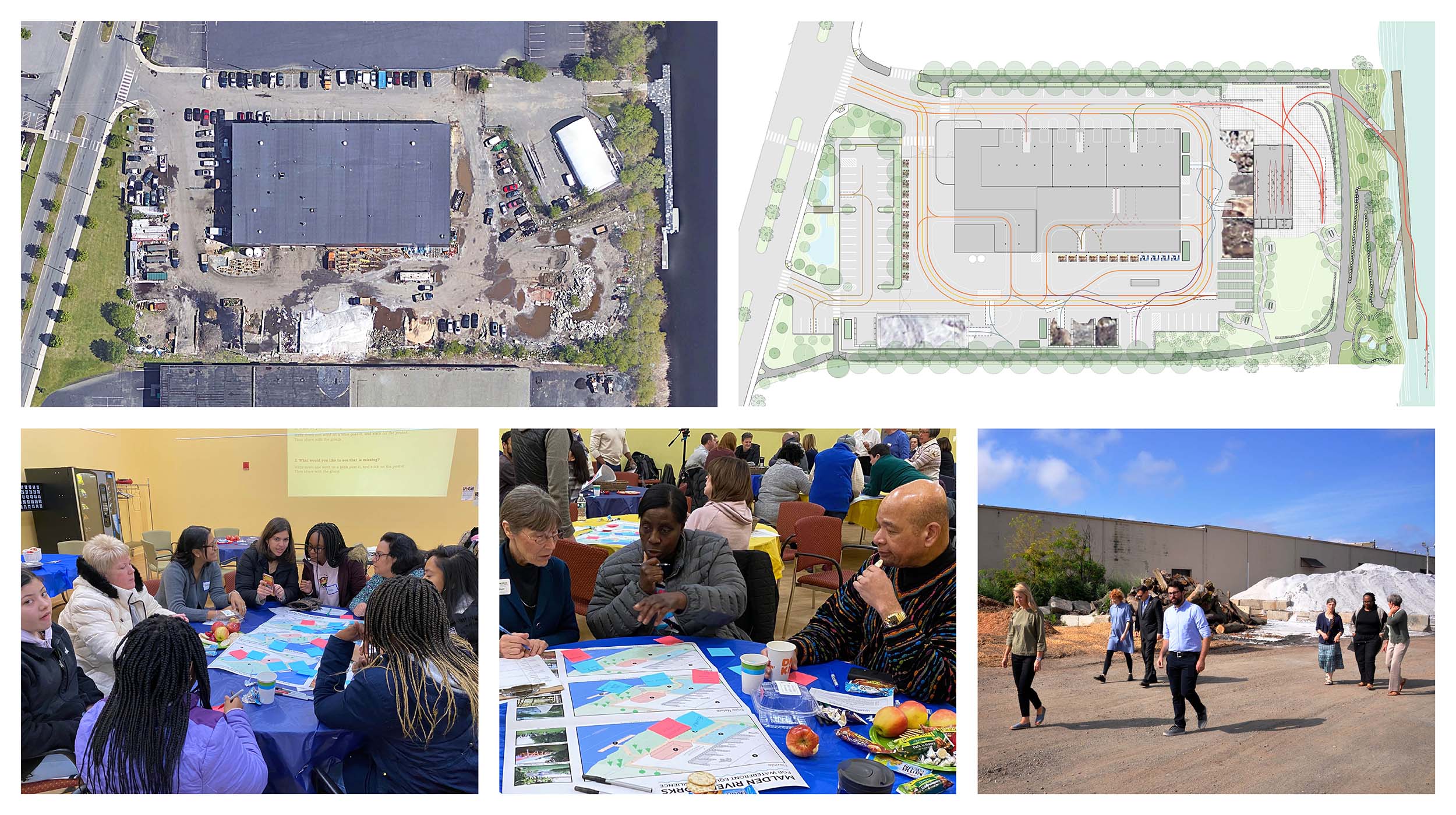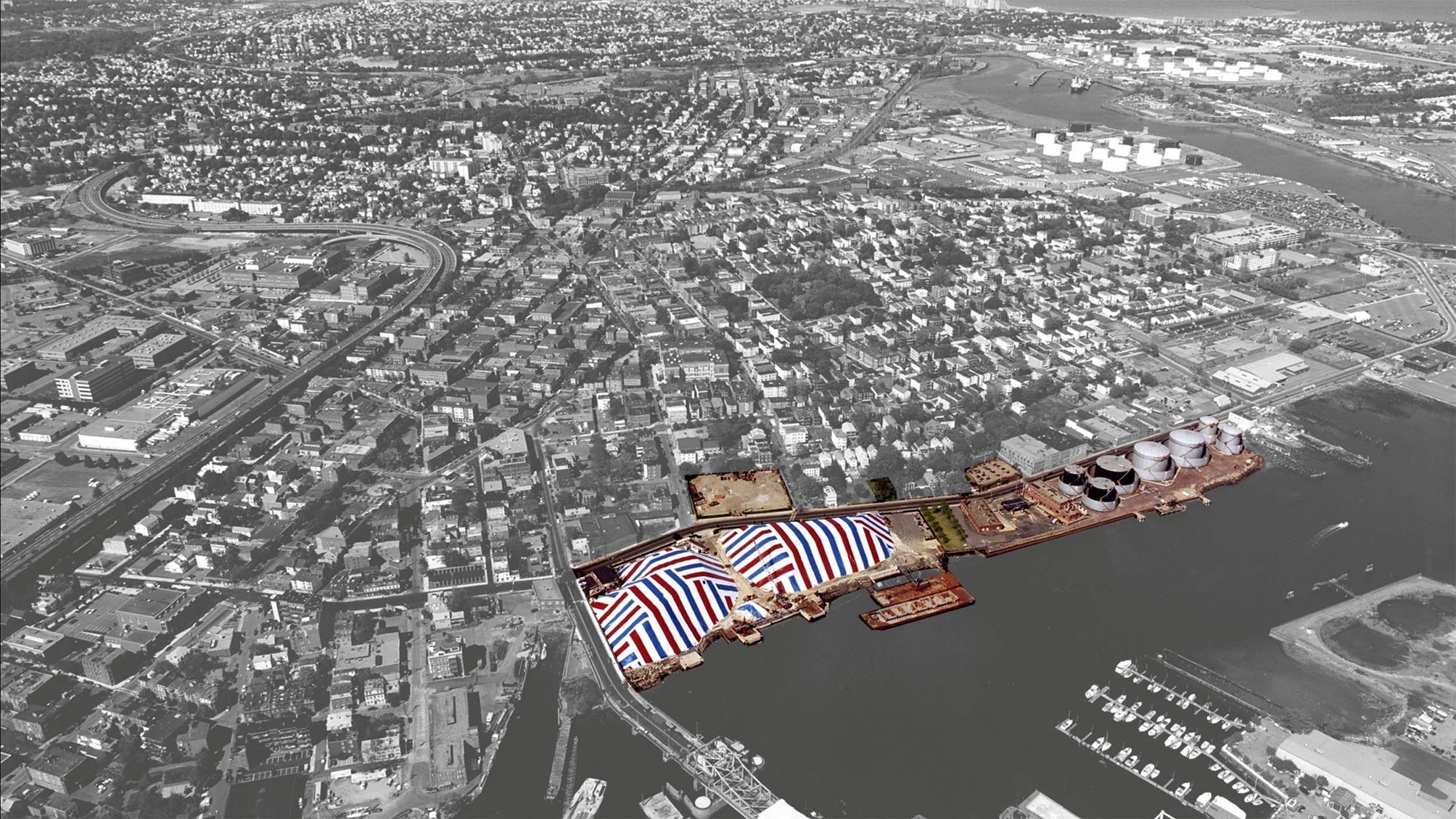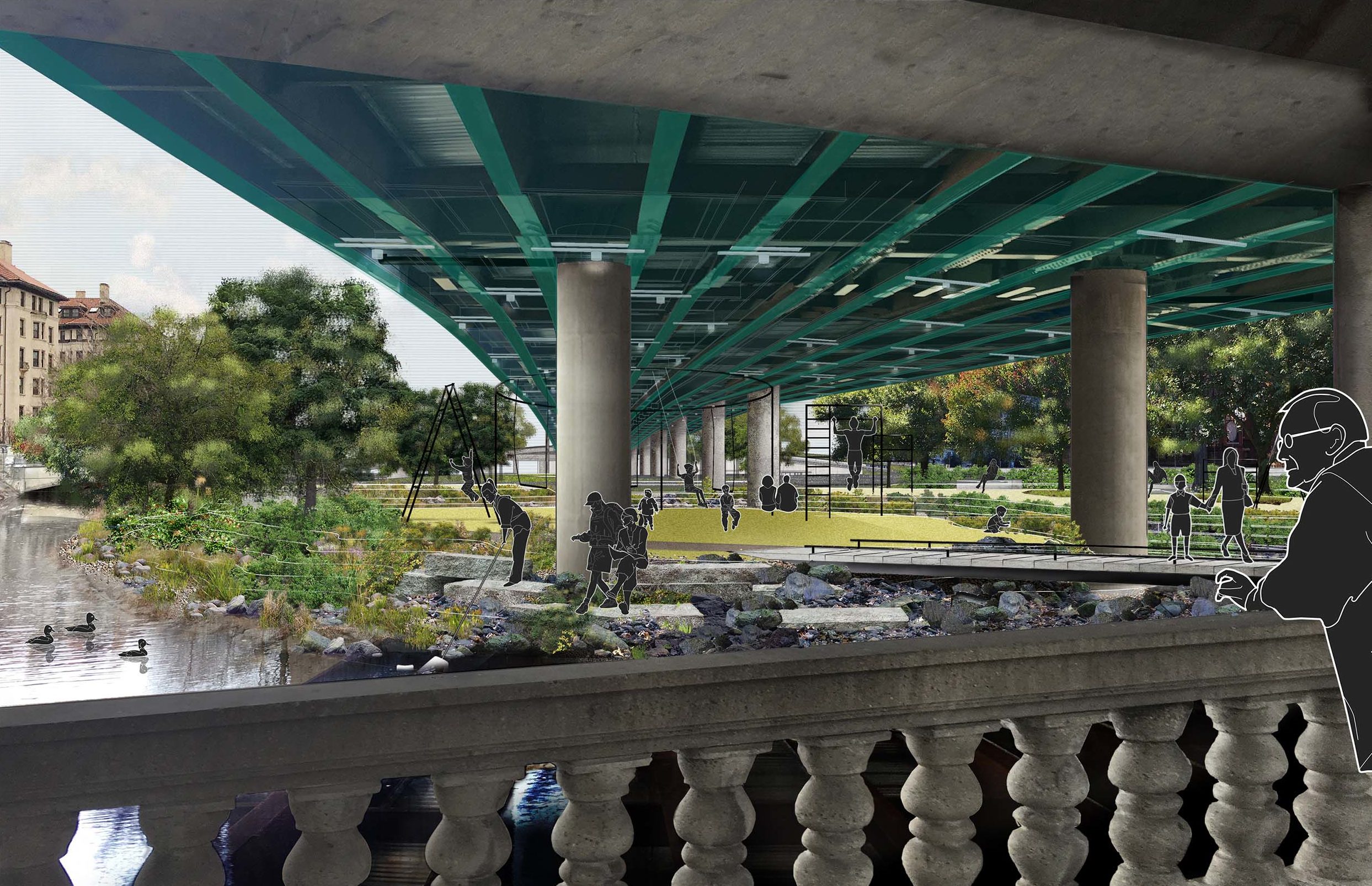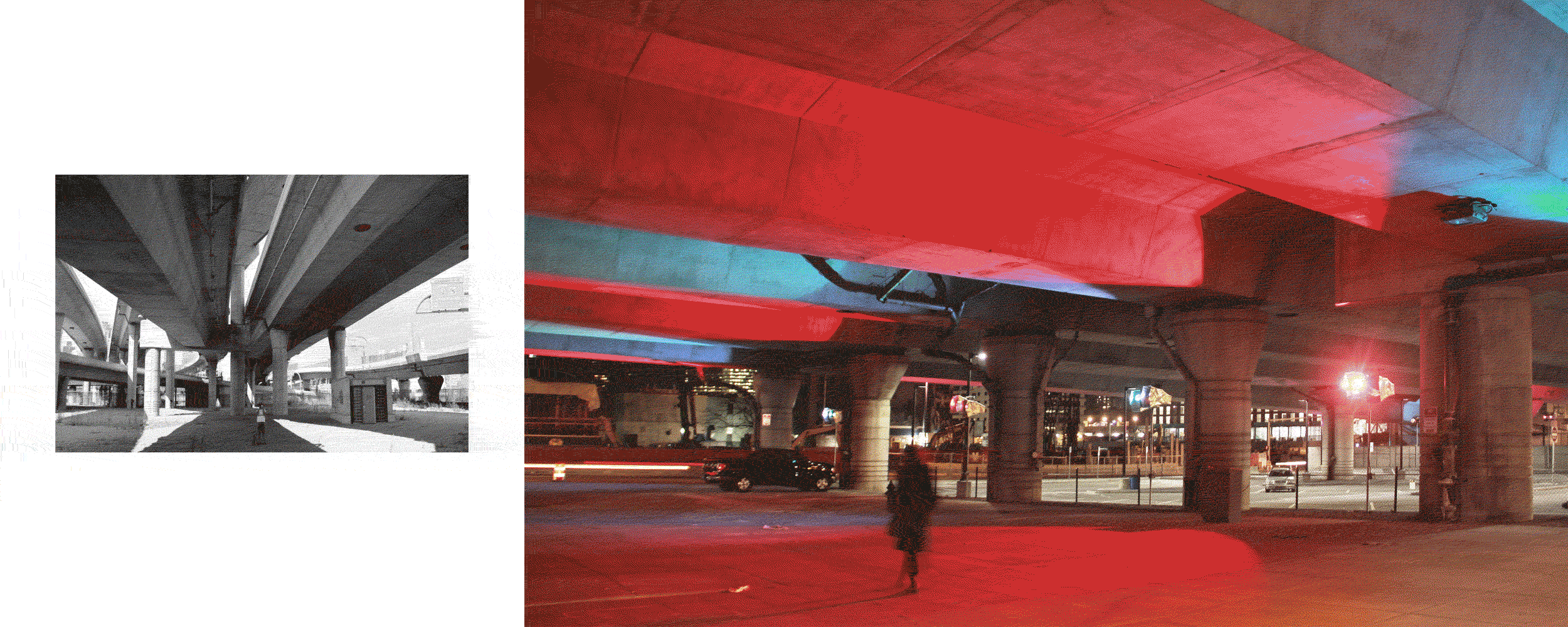This Land Is Whose Land?
To make infrastructure and industrial sites better neighbors within cities, Landing Studio addresses complex questions of ownership and governance.
March 23, 2022

Landing Studio's Infra-Space 1 / Underground at Ink Block project turned an 8-acre site beneath a highway in Boston into a public park. The project was a pilot for a Massachusetts Department of Transportation initiative seeking to improve the public realm and environmental performance of highway underpasses. Image credit: Landing Studio
Although highways, ports, and other urban infrastructures often loom large, literally and figuratively, over surrounding neighborhoods, they’re frequently ignored by architects and planners. Dan and Marie Law Adams, the principals of Somerville, Massachusetts, firm Landing Studio, have dedicated their practice to exploring these spaces, seeking to reconcile industrial and infrastructural operations with the needs of the communities that host them.
Producing meaningful, lasting change in these environments requires grappling with complex issues of ownership, governance, and scale. The League’s Rafi Lehmann and Sarah Wesseler spoke with Landing Studio about this work.
*
Sarah Wesseler: Your practice touches on so many of the large-scale forces that have shaped American cities over the last few generations, from highway construction to industrial decline and gentrification. Speaking very generally, how do you think about the historic context that’s shaped the sites you deal with?
Dan Adams: One thing that unifies a lot of the sites we work on is a kind of scalar imbalance. Things like major port facilities or highway systems are designed to be beneficial at a regional, federal, or international scale, but at the neighborhood level they can be really devastating. And when you look at the history of the federal highways, for instance, some of that imbalance was created by problematic logics of urban renewal that intentionally carved these major infrastructures into disempowered neighborhoods. So our work has almost always come out of the discord between large-scale infrastructure systems and local communities, trying to resolve that relationship.
Marie Law Adams: We do address somewhat different issues in different projects, though. On industrial sites there’s an explicit anti-gentrification theme, trying to preserve industrial jobs and activity while bringing in other uses, like public access to the waterfront. For the highway sites it’s more about mitigating the impacts of heavy infrastructure in local environments. Our project under I-93 in Boston redesigned the ground plane so that it better serves the neighborhoods around it, creating connections rather than fragmenting them and so on.
There’s also a third category, where we have an opportunity to reimagine what infrastructure can be in a community, designing it better from the outset. The Emerald Gateway project, for instance, reorganizes a piece of roadway infrastructure to put public realm and ecological systems first, versus other projects where we’ve inserted new human and ecological connectivity within an existing space of infrastructure.
Rafi Lehmann: Could you tell us about the different types of clients you work with and how that impacts your design process? And how does the question of clients overlay with issues of ownership and governance as you work on these projects with multiple scales?
Dan Adams: Some of our clients have been private industries; others have been government agencies or community advocacy groups. But the intent is often similar: They want to create a public realm that’s more considerate of the different scales of communities impacted by infrastructure.

The historic entrance to Boston's Olmsted-designed Emerald Necklace park system (top left) was destroyed by highway construction (above middle, shown with additional erasures of the urban fabric resulting from urban renewal projects). Landing Studio's proposed transformation of the Emerald Gateway site (right) removes and reconfigures a waterfront highway exchange to reconnect park and river systems. For this project, the client group includes the Emerald Necklace Conservancy, a private nonprofit stewardship group, and the Charlesgate Alliance, an advocacy group focused on the neighborhoods around the site; the Massachusetts Department of Conservation and Recreation and Department of Transportation are also consulting on the effort. Image credits, counterclockwise from top left: Olmsted, Olmsted & Eliot, public domain, via Wikimedia Commons; Landing Studio; Landing Studio
But “client” is a really complicated concept in a lot of these projects. The environments we work in are often underutilized or vacant, so people often think that no one is interested in these sites—but we often find that it’s quite the opposite. The sites often fall into stagnation because they’re so contentious, governed by organizations or agencies with different interests.
For example, many sites we’re involved with operate under federal regulations and straddle dispersed interests from state transportation, conservation, or environmental protection agencies, while sometimes being managed as city or state parks or transit corridors. So one aspect of our work is developing designs that can creatively negotiate those interests and balance the uses on the site.
Almost all our sites have varying degrees of governance, so defining the client is one of the first things we do. A great example is the Emerald Gateway project, where we spent over a year just trying to figure out ownership of water on the site. When the rain falls in the street, it’s in one jurisdiction. As soon as it’s in the pipe, it’s owned by someone else. As soon as it discharges into a river, it’s owned by someone else.
It changes your conception of architecture when you start thinking about things ecologically like this. It’s not so much “Oh, who owns this piece of property or building?” but rather “Who owns the systems that flow through the site?” and then, therefore, “Who’s responsible for making decisions?”

Landing Studio researched the ownership of drainage infrastructure on the Emerald Gateway site in order to help public agencies agree on a new green infrastructure plan. The existing system is shown at top, with each color representing a unique jurisdictional condition; Landing Studio's proposed design, which simplifies ownership, is shown at bottom. Image credit: Landing Studio
One of the things we grapple with a lot is that even when everything is managed by state agencies, particular agencies will say, “Well, that’s that other group’s responsibility.” But at the end of the day, this infrastructure is all part of the public domain, and we should tackle it as one consistent system.
Marie Law Adams: In terms of ownership, there are really three considerations that always affect the project for us. One is, who’s the proponent of the project—who hired us, and who are we working for? Second, who are the relevant jurisdictional authorities? Usually there’s not just one, but many. And third, who are the stakeholders? Who else do we need to be thinking about?
One project that’s been very different in this respect is the Malden River Works, which has been entirely initiated by grants from the state and MIT. The design is driven by community interests.
Dan Adams: That’s a great example, because a lot of what that design effort actually involved, in a way, was designing a client—working with community members, working through grant programs, working with the City to build an advisory group that’s responsible for guiding all the decisions related to the project’s direction and use of funds.

The Malden River Works project seeks to establish the first public park ever housed on the industrial riverfront of Malden, Massachusetts. Landing Studio's work has included guiding the development of the site's Steering Committee, a coalition tasked with overseeing the creation of public space while preserving industrial uses. Top left: Existing site. Top right: Site reorganized to meet goals of public access and climate resilience. Bottom: Discussions and tours with the Steering Committee, members of the public, and the project team. Image credits, clockwise from top left: Google Earth, Landing Studio, Jonah Susskind, Landing Studio, Landing Studio
An interesting aspect of this type of project is that it involves developing long-term relationships. One critique we have of the contemporary discourse on sustainability is that architects are often contracted in these very finite relationships to places and sites, yet sustainability is about the long-term life of something. We’ve been able to take a longer-term approach for a lot of our projects.
I think our perspective on this comes from our history working with industrial clients, because they’re constantly building, both developing new facilities and advancing existing ones—they build the facility, they maintain the facility, they operate the facility. So you become sort of an on-call architect, responsible for designing a project and implementing it, but also maintaining it over time.
Something that’s become more and more interesting to us is getting in advance of the architectural project. How do you build community groups, build consensus across jurisdictions, as part of reshaping infrastructure’s potential? Our work is moving to a model where architecture isn’t understood as discrete design and building projects, but instead deals with designing and building within the life of communities, the life of cities and places.
Sarah Wesseler: I would think a lot of that kind of work would typically be done by something like a city planning department. How do you think about your practice, or the agency of architects more generally, in relation to a model where you respond to RFPs developed by planners?
Marie Law Adams: A lot of the sites we’ve worked on are state-owned, so there is no local planning authority. That creates a gap in all kinds of planning initiatives—in terms of climate resilience, for example. And it can also leave local stakeholders out: Who the state listens to is really different than who a local municipality listens to.
Other times, we find that the kinds of issues happening on these sites don’t have a clear solution, which can prevent local municipal planners from taking action. In almost all our projects, there was no design brief when we started.
Dan Adams: It’s interesting—very early in our work, when we’d say we were working on ports and highways, we’d often get, “Oh! That’s a very interesting niche you’re working in!” [laughs] This kind of infrastructure is often seen as an anomaly within urban environments. Planning authorities typically don’t have highly nuanced approaches for it, whereas there are all sorts of zoning strategies or planning studies for things like neighborhood block structures and building height. When you zoom out on a city, though, you see that highways and ports aren’t anomalies at all—they’re often the fundamental structures dictating how neighborhoods are broken up.
Marie Law Adams: This is a vestige of history, too. The highway sites we work with were established in the 1950s and ’60s, when planning processes were a lot less responsible to local communities and often intentionally targeted disempowered populations. But they’re still the same sites and some of the same communities, and there’s still often a very tokenized community engagement process.
Sarah Wesseler: For your first project, Rock Chapel Marine and P.O.R.T, your client was a private company. Can you talk about the transition from working with private landowners to working for government agencies?
Dan Adams: That was a great opportunity for us to begin our career with, because it was a very in-depth analysis of industrial and infrastructure systems. We spent a decade studying the company’s operations.
That work demonstrated how notions of public and private are very complicated—it’s not so simple as one versus the other. The client is a private company, but it operates very much as a public infrastructural resource, providing road salt to cities, towns, municipalities. And it operates on multiple waterfronts, which are public spaces, legally, in Massachusetts.

Site of the Rock Chapel Marine & The P.O.R.T. project on the Chelsea, Massachusetts, waterfront. Image courtesy Landing Studio
That project helped us understand maintenance regimes of infrastructure from the client’s perspective—trying to make a truly sustainable infrastructure for their own operations. And on the other hand, how do you, as an industry and as an infrastructure, create sustainable relationships within dense urban environments? The client brought us on because they wanted to develop a better relationship with their neighbors. They were like, “Well, we’ve been here for 50 years and we do a lot in the community, but for the sustainability of our business we need a better relationship with our neighborhood.”
That long participation with them—we still work with them on the Chelsea waterfront—is essentially designing the relationship between the city and the industry. Over time, it’s revealed all sorts of lessons and opportunities to rethink the boundary between infrastructure and communities.
For example, in one of our early projects with them, we were able to work out, OK, salt’s mainly used in the winter around here, and parks are mainly used in the summer—so a basketball court could have salt on it in the winter and kids can play on it in the summer. And that changes your thinking. At first you think a salt dock and a basketball court have nothing to do with each other, but then you realize that actually they’re almost exactly the same thing. They’re essentially a slab of asphalt with drainage, and they happen to have a great seasonal sharing. That was a revolutionary realization for us: If you stop thinking so typologically and look at things in terms of their systems and material operations, they might be the same in some ways.
Seasonal transformation from salt pile to basketball court. Image credits: Landing Studio
That logic was really interesting when we started looking at transportation infrastructure. Federal and state regulations specifically say that tax dollars allocated to transportation infrastructure cannot be used to build public parks. But then you step back and realize, OK, well, mobility is transportation infrastructure—so that means bikes and pedestrian pathways. And the second you build a pedestrian pathway, you need to have a bench and lighting to support it. And the water management off of a highway is part of the highway infrastructure, so you can build stormwater management—green infrastructure, trees and grasses.
So you can use transportation funds to build bike lanes and pathways and lighting and benches and landscaping. And if you put it all together and shape it a certain way, that’s transportation infrastructure, but it’s basically a public park too. The capital spent on building this public infrastructure is just designed with multiple constituents in mind.

Rendering of proposed public park to be sited under a highway as part of the Emerald Gateway project. Image credit: Landing Studio
Rafi Lehmann: To what extent do you see yourself as advocates? You work with all these different actors: proponents, stakeholders . . . Who are you advocating for? And do you come across resistance when trying to represent multiple groups?
Dan Adams: We always see ourselves as advocating for a quality, productive public realm—and that is a really complicated subject.
For instance, with the industrial work, there are so many examples of industry being vacated from cities and being replaced by a park, and seemingly you have a better public realm because you now have a park. But then you reflect on, well, what about all the displaced jobs? And you think about economic diversity in cities and, well, we’ve just wiped out a whole tier of types of jobs, in terms of training necessary for jobs, levels of education available for jobs, even just preferred types of crafts in a city. Not to mention the dislocation of communities served by that infrastructure.
Marie Law Adams: One thing that’s important to say is that we can’t advocate for a good public realm without working with the people who are going to use that space. We do not believe there are universal principles, necessarily, to make good public space that works everywhere. There are a lot of lessons about what doesn’t create good public spaces, like a lack of crosswalks or other really simple things that should be present. But being able to have conversations during the design process is really important.
Interview edited and condensed.
Explore
The Road to Equity
For Kounkuey Design Initiative, transportation planning projects are one way to improve the built environment for everyone.
Material flows, ecosystem growth, and urban landscape renewal
Paul Mankiewicz explores ways to improve the environmental, infrastructural, and economic health of cities.
The Image of Water
Communities throughout Mexico face severe challenges with water. Addressing them requires cultural as well as physical interventions, says Taller Capital.



